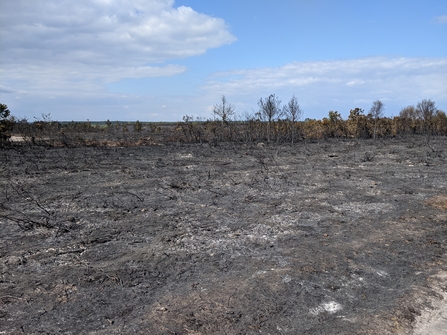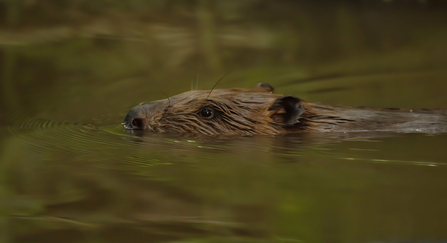Climate change is caused by the rapid warming of our planet’s atmosphere primarily due to the burning of fossil fuels that generate greenhouse gases. Other major contributors of carbon dioxide and methane are the agricultural sector, industry, land clearance and waste disposal. Climate change does not necessarily just mean warmer temperatures, but includes consequences such as intense droughts, water scarcity, severe fires, rising sea levels, flooding, melting polar ice, more frequent and severe storm events and declining biodiversity.
Climate change, ecosystems and species resilience:

Surrey Wildlife Trust's Ash Ranges after fire damage by Adam Boulton
Biodiversity is the term used to describe all the different species of animal, plant, fungi and microorganisms found in the natural world. These species and organisms form part of a connected and balanced system that interacts with the physical environment called an ecosystem. Some species are ecosystem engineers, such as the beaver, which create new complex habitat through their natural behaviour of damming watercourses. Healthy ecosystems can provide 37% of the mitigation needed to limit global temperature rise, but damaged ecosystems can release carbon rather than store it. For example, peatlands are a terrestrial wetland ecosystem where waterlogged conditions prevent plant material from fully decomposing. This results in the accumulation of organic matter (peat) and the creation of a peatland which in turn stores and sequesters more carbon than any other form of terrestrial habitat. However, if drained or damaged, they can become a major emitter of greenhouse gases. In their natural, wet state, peatlands provide indispensable Nature-based Solutions (NbS) for adapting to and mitigating the effects of climate change.

Healthy peat landscape (c) Peter Cairns/2020VISION
In terms of species, rapid warming is limiting the ability of many species to adapt to their new environment and is increasing the likelihood of extinction across the globe. Species that are more physically able to move, such as birds, can disperse to more favourable climatic zones, however this does not necessarily mean that the species within their food chain can also move at the same rate, for example plants or snails. Species at the bottom of the food chain can be the ones to feel the impacts of climate change first, and the full impact on species higher up may not be seen for many years.
Species are intrinsic in ecosystem function, and their loss through dispersal or extinction can change entire habitats, which will then impact all other associated species. In some cases, species can also become extinct due to direct habitat loss; examples include rising sea levels claiming terrestrial habitats, the drying of wetlands, or the warming of polar habitats. Species may need to shift their range to more northerly regions or zones of higher altitude. Rising temperatures can also lead to other challenges; ecological changes (changing migration patterns), biological changes (earlier breeding times), physiological changes (altered sex ratio in reptiles) and genetic changes (interbreeding). Disease rates can increase with a warmer and wetter climate, and the proliferation and spread of invasive species can also have a very detrimental effect on biodiversity.
Resilience is the ability of an ecosystem or species population to absorb change and return to the same equilibrium state after a temporary disturbance. Ecosystems with higher species diversity tend to be more resilient and species able to disperse and maintain genetic diversity are also more resilient. In the UK and through the Wye Adapt to Climate Change? project, we hope to enhance natural habitats to build resilience across the farmed landscape and beyond.
The team in Radnorshire are working in areas of peatlands to promote good habitat management, and in some areas undertaking efforts to restore this habitat. The work encompasses advice on livestock management (changing from sheep to hardy breeds of cattle), and habitat creation (ponds, scrapes, peat dams and leaky dams). The ultimate aim is to hold more water on the land allowing the re-wetting of peatlands. Restoring ecosystem function can provide carbon sequestration benefits once again as well as providing habitat for specialised species of plants, fungi and animals.
An example of project work where the focus is on connectivity is at Wyevale Nurseries. Wyevale Nurseries is a family-run horticultural business on the outskirts of Hereford that produces plants and trees. They have engaged with the project to explore ideas of how the business could develop with climate adaptation in mind. The plans at Wyevale Nurseries encompass improving the habitat either side of the Yazor Brook (blue corridor) that runs through the site. The watercourse will be fenced off from livestock and woodland buffer strips will be planted with wet tolerant tree species such as alder, willow and birch. This protects the brook from the impacts of livestock such as poaching and erosion, nutrients entering the brook, whilst also providing Natural Flood Management (NFM) benefits by slowing the flow of surface water runoff. Some parcels of land across the site which are not being used for production, have been scoped to provide more complex habitat through woodland creation, creation of wetland features such as scrapes and ponds, and meadow restoration. Connecting existing pockets of habitat and newly created features/areas, involves improving the hedgerow network and creating wider buffers and margins of wildflower mixes or rough grassland strips (green corridors). Connecting areas of existing habitat or developing habitat corridors enables wildlife to move across the landscape in response to extreme weather events such as flooding, drought and wildfires
In conclusion, prioritising nature conservation and adopting methods of climate change adaptation can enhance species survival in the future. The Wildlife Trust is working to the principle of “bigger, better and more joined up”, which are recommendations derived from the 2010 Lawton Review (Making Space for Nature report). Working with these key principles in mind, can bring about positive change to landscapes that will help species adapt to climate change.
If you are interested in learning more, please contact one of the Project Officers below:
Wye Valley National Landscape: Holly Williams
h.williams@herefordshirewt.co.uk
Herefordshire Wildlife Trust: Holly Thompson
h.thompson@herefordshirewt.co.uk
Radnorshire Wildlife Trust: Sarenta King
For further information on climate change and the other topics covered in this blog, please visit the United Nations Climate Action website and IUCN resources:
https://www.un.org/en/climatechange/climate-fast-facts
https://iucn.org/resources#resource_types-resource_type_issue_brief

Beaver swimming with its head just above the water © Russell Savory

